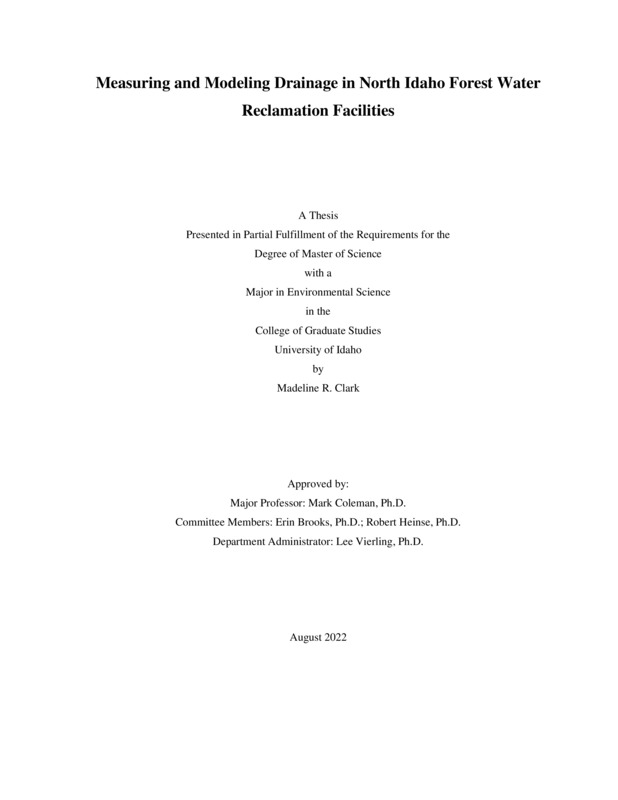Measuring and Modeling Drainage in North Idaho Forest Water Reclamation Facilities
Clark, Madeline Rose. (2022-08). Measuring and Modeling Drainage in North Idaho Forest Water Reclamation Facilities. Theses and Dissertations Collection, University of Idaho Library Digital Collections. https://www.lib.uidaho.edu/digital/etd/items/clark_idaho_0089n_12383.html
- Title:
- Measuring and Modeling Drainage in North Idaho Forest Water Reclamation Facilities
- Author:
- Clark, Madeline Rose
- Date:
- 2022-08
- Keywords:
- Drainage Forest hydrology Model Soil hydrology Wastewater irrigation
- Program:
- Environmental Science
- Subject Category:
- Forestry; Soil sciences; Hydrologic sciences
- Abstract:
-
A growing human population requires sustainable options to regulate and dispose municipal wastewater. In northern Idaho, wastewater treatment facilities are permitted by the Idaho Department of Environmental Quality to apply reclaimed wastewater to areas of forest during the growing season. One of the intentions of this land application is to dispose the reclaimed wastewater while protecting the quality of nearby freshwaters. To avoid excess irrigation, the Idaho Department of Environmental Quality provides facilities with monthly hydraulic loading rates. Drainage measurements below the rooting zone provide quantifications of deep soil drainage, allowing for an assessment of drainage patterns during the growing and non-growing season. No drainage occurred throughout two months of the seasonal drought, but large magnitudes of drainage were recorded during the shoulder months of the growing season. To predict drainage in plots where drainage measurements were not possible, we quantified potential drainage in irrigated forests using hydrological models (Hydrus-1D and Water Erosion Prediction Project). Hydrus-1D and Water Erosion Prediction Project were successful at predicting observed and potential drainage during the growing season. There was not a statistically significant difference between the measured monthly drainage data and the predicted monthly drainage values during the growing season. However, the models were less effective or incapable of precise non-growing season drainage estimates. Annual measured drainage at control plots differed from measured drainage at effluent plots at some facilities. There was large variation in annual measured drainage between effluent plots at four of the facilities. As shown through the models, the estimated crop coefficient recommended by the Idaho Department of Environmental Quality is sufficient in avoiding drainage during the growing season in north Idaho forest systems. Potential drainage is predicted to begin following the treatment season and the start of the autumn wet-season. Drainage quantification is a necessary component to calculate the nutrient flux of forests irrigated with reclaimed wastewater. Based on the findings in this study, there is an elevated risk for nutrient leaching to nearby freshwaters with large magnitudes of drainage occurring during the shoulder months of the growing season and throughout the non-growing season.
- Description:
- masters, M.S., Environmental Science -- University of Idaho - College of Graduate Studies, 2022-08
- Major Professor:
- Coleman, Mark D
- Committee:
- Brooks, Erin; Heinse, Robert; Vierling, Lee
- Defense Date:
- 2022-08
- Identifier:
- Clark_idaho_0089N_12383
- Type:
- Text
- Format Original:
- Format:
- application/pdf
- Rights:
- In Copyright - Educational Use Permitted. For more information, please contact University of Idaho Library Special Collections and Archives Department at libspec@uidaho.edu.
- Standardized Rights:
- http://rightsstatements.org/vocab/InC-EDU/1.0/

